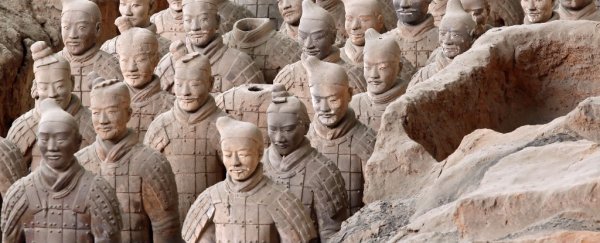The 8,000 terracotta warriors that have kept watch over the tomb of China's first emperor for more than 2,000 years were the result of outside influence, new evidence suggests.
Based on DNA remains found on the site, archaeologists think ancient Greek sculptors could have been on hand to train local artists - a find that could overturn centuries-old assumptions about contact between the East and the West before Marco Polo.
"We now have evidence that close contact existed between the first emperor's China and the West before the formal opening of the Silk Road. This is far earlier than we formerly thought," Li Xiuzhen, a senior archaeologist at the Emperor Qin Shihuang's Mausoleum Site Museum in China, told Maev Kennedy at The Guardian.
"We now think the Terracotta Army, the acrobats, and the bronze sculptures found on site, have been inspired by ancient Greek sculptures and art."
The Terracotta Army was discovered back in 1974 by local farmers in the Lintong District of Xi'an - one of the oldest cities in China, located slightly to the northeast of the country's centre.
Buried underground for centuries with the remains of China's first emperor, Qin Shi Huang, the army is spread across a vast funerary complex, made up of three massive pits, containing more than 8,000 soldiers and 150 cavalry horses, plus 130 chariots pulled by 520 horses.
It might be the most famous - and massive - pit of terracotta warriors found in China, but it certainly isn't the only one.
Many more pits of terracotta soldiers have been found across the country, but they're all much smaller, and tend to be far more stylised than these highly detailed and realistic depictions of Emperor Qin's real-life army.
As the BBC explains, there was no tradition of building life-sized human statues in China before this tomb was created, and nothing like this terracotta army has ever been uncovered in the country since. So why the sudden change in style?
Archaeologists and historians working on the site have uncovered traces of European mitochondrial DNA from skeletons buried nearby, which suggests that Westerners might have settled, lived, and died in the area even before the rule of the First Emperor.
They have also matched the style of terracotta acrobats and bronze figures of ducks, swans, and cranes in the royal tomb to ancient Greek art of the same time period.
The team, which includes experts from institutions all over the world, says these could be indications that the East and the West were in regular contact more than 1,500 years before Venetian merchant Marco Polo hit the scene, and the Greeks might have shared their sculpting techniques with the local Chinese artisans.
"I imagine that a Greek sculptor may have been at the site to train the locals," Lukas Nickel, chair of Asian art history at Vienna University in Austria, told The Guardian.
The new evidence is the result of a large-scale investigation into the pits, which involved the use of remote sensing, ground-penetrating radar, and core sampling to reveal hidden sections of the funerary complex.
As A. R. Williams reports for National Geographic, the tomb is far larger than previously thought - covering some 98 square kilometres (almost 38 square miles) - and thanks to the investigation, a number of new burials have been uncovered at the site.
"Archaeologists have discovered mass graves that appear to hold the remains of the craftsmen and labourers - including convicted criminals in chains - who died during the three decades it took to create the royal mausoleum," says Williams.
"Other mass burials seem to tell grisly tales of a brutal struggle to capture the emperor's throne."
Of course, the evidence is all circumstantial at this point, so until more definitive proof comes to light, the hypothesis that Greek travellers worked with the Chinese to create the terracotta warriors remains just that.
And there'll be a lot of pressure on the team to back their speculation up with something more substantial, because foreign influence on one of the most iconic works of art in Chinese history is bound to be controversial.
But if a case can be made to support this scenario, it will force an entire rethink on what historians had assumed about Western contact with China more than 2 millennia ago.
Until now, it was believed that Marco Polo was among the first Europeans to make contact with China in the 13th century, but thanks to the DNA evidence, we now know that Europeans were there well ahead of Marco Polo - but in what capacity is anyone's guess.
The results of the investigation will be revealed in the documentary, The Greatest Tomb on Earth, made by the BBC and National Geographic, which will be screened later this month. We're holding out for a peer-reviewed paper on the studies before we get too excited, but we can't wait to see where this research leads.
